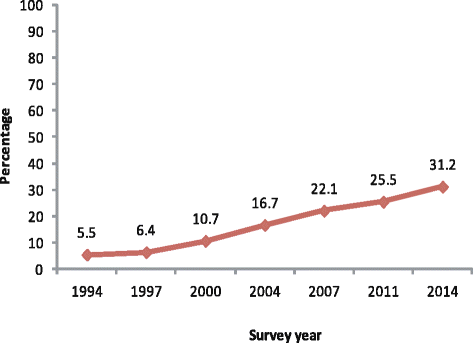Trends, determinants and inequities of 4+ ANC utilisation in Bangladesh
- PMID: 28086970
- PMCID: PMC5237328
- DOI: 10.1186/s41043-016-0078-5
Trends, determinants and inequities of 4+ ANC utilisation in Bangladesh
Abstract
Background: The objectives of this study are to document the trend on utilisation of four or more (4+) antenatal care (ANC) over the last 22 years period and to explore the determinants and inequity of 4+ ANC utilisation as reported by the last two Bangladesh Demographic and Health surveys (BDHS) (2011 and 2014).
Methods: The data related to ANC have been extracted from the BDHS data set which is available online as an open source. STATA 13 software was used for organising and analysing the data. The outcome variable considered for this study was utilisation of 4+ ANC. Trends of 4+ ANC were measured in percentage and predictors for 4+ ANC were measured through bivariate and multivariable analysis. The concentration index was estimated for assessing inequity in 4+ ANC utilisation.
Results: Utilisation of 4+ ANC has increased by about 26% between the year 1994 and 2014. Higher level of education, residing in urban region and richest wealth quintile were found to be significant predictors. The utilisation of 4+ ANC has decreased with increasing parity and maternal age. The inequity indices showed consistent inequities in 4+ ANC utilisation, and such inequities were increased between 2011 and 2014.
Conclusions: In Bangladesh, the utilisation of any ANC rose steadily between 1994 and 2014, but progress in terms of 4+ ANC utilisation was much slower as the expectation was to achieve the national set target (50%: 4+ ANC utilisation) by 2016. Socio-economic inequities were observed in groups that failed to attend a 4+ ANC visit. Policymakers should pay special attention to increase the 4+ ANC coverage where this study can facilitate to identify the target groups whom need to be intervened on priority basis.
Keywords: Antenatal care; Bangladesh; Determinants; Inequality; Trends.
Figures
References
-
- World Health Organization. Trends in maternal mortality: 1990 to 2013. Estimates by WHO, UNICEF, UNFPA, The World Bank and the United Nations Population Division. Geneva: World Health Organization; 2014.
-
- National Institute of Population Research and Training. Bangladesh demographic and health survey 2014: Key Indicators. Dhaka: National Institute of Population Research and Training; 2015.
-
- National Institute of Population Research and Training. Bangladesh demographic and health survey 2011. Dhaka: National Institute of Population Research and Training; 2013.
-
- Anwar I, Kalim N, Koblinsky M. Quality of obstetric care in public-sector facilities and constraints to implementing emergency obstetric care services: evidence from high- and low-performing districts of Bangladesh. J Health Popul Nutr. 2009;27(2):139–55. doi: 10.3329/jhpn.v27i2.3327. - DOI - PMC - PubMed
MeSH terms
LinkOut - more resources
Full Text Sources
Other Literature Sources
Medical



